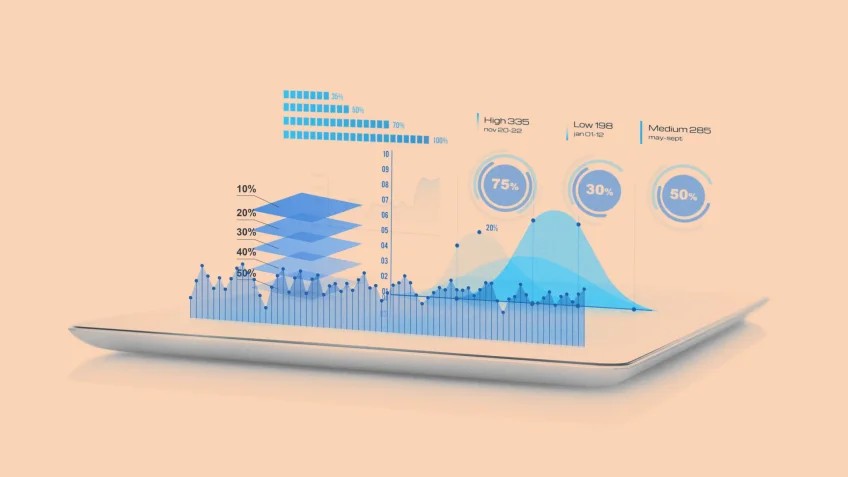July 2nd, 2025
Data Analysis Using No-Code AI Business Tools
By Simon Avila · 5 min read

Business intelligence (BI) tools, software solutions designed to analyze business data and provide actionable insights, are undergoing a significant transformation. The integration of artificial intelligence (AI) is propelling these tools beyond traditional dashboards, ushering in an era of real-time insights, smarter automation, and predictive analytics that are fundamentally changing how businesses make decisions.
This evolution is making sophisticated data analysis accessible to a broader audience, particularly through no-code AI platforms [1], [2].
The Ascendance of AI in Business Intelligence
AI-powered BI tools streamline the entire analytics process by automating repetitive tasks and delivering actionable insights, which significantly reduces the reliance on manual data analysis. The fusion of AI into BI platforms is making analytics more predictive and more accessible to users without technical expertise [1], [2].
Tangible Benefits of AI-Powered Business Intelligence Tools
The adoption of AI-powered business intelligence tools offers several advantages. These advanced systems help organizations enhance operational efficiency, bolster decision-making processes, and reduce costs by innovatively collecting, processing, and visualizing data [1].
Because our current landscape is so competitive, these tools are no longer a luxury but a necessity. They enable teams to swiftly spot emerging trends, automate complex workflows, and visualize multifaceted data sets for superior business outcomes. Plus, the integration of AI in the workplace is set to empower employees, unlock novel efficiencies, and generate substantial value across various industries [2].
Market Growth and Key Features
The global business intelligence software market reflects this transformative impact. Projections indicate a substantial growth trajectory, with the market expected to grow significantly through the decade [3]. AI-powered business intelligence tools are particularly sought after for their predictive maintenance capabilities, assisting companies in anticipating market shifts and optimizing revenue streams [3].
Modern AI BI tools, including leading platforms like Microsoft Power BI, Tableau, and others, are characterized by several key features:
• AI-Powered Analytics: Identifying trends and anomalies automatically [4].
• Real-Time Data Analysis: Providing up-to-the-minute insights.• Extensive Data Connectivity: Integrating with diverse data sources [4].
• Ease of Use and Scalability: Catering to businesses of all sizes and user skill levels [4].
• Interactive Dashboards and Dynamic Reporting: Facilitating faster, more informed decision-making through automated insights [4].
How No-Code AI Is Democratizing Data Analysis with Leading Tools
A significant development in the AI BI landscape is the rise of no-code platforms. These tools are democratizing data analysis by making sophisticated AI-powered business intelligence tools accessible to non-technical users [1], [2], [4].
Examples of no-code platforms include DataRobot, Levity, Peltarion, and Graphite Note. These tools allow users to analyze, visualize, and manipulate data through intuitive interfaces, often supporting file uploads, graph and chart generation, data cleaning, and merging—all without programming knowledge [4], [3]. This empowers knowledge workers who may lack dedicated analyst support and data scientists seeking to automate tedious manual tasks.
AI's Impact on Market Research
The application of AI extends profoundly into market research, a critical subset of business intelligence. AI-powered market research tools automate tasks like survey creation, rapidly analyze vast datasets, and identify subtle patterns that human analysts might overlook.
These tools support a range of crucial activities, including:
• Competitive intelligence
• Social media sentiment analysis
• Predictive analytics
• Automated reporting [3]
By leveraging Natural Language Processing (NLP) and advanced algorithms, these tools extract actionable insights from unstructured data, making findings more accessible and accurate.
Platforms such as Quantilope and Brandwatch streamline research processes, automate data analysis, and provide real-time, predictive insights by tapping into diverse data sources like web content and customer interactions. This helps businesses to enhance competitor analysis, detect market shifts, and support rapid, data-driven decision-making for sustained market leadership [3].
The Future Is AI-Driven
The potential for AI to enhance productivity is immense. Industry research estimates that AI could contribute trillions of dollars annually in added productivity growth potential from various corporate use cases, including business intelligence [2]. The continued adoption of AI in the workplace is expected to further empower employees, unlock new efficiencies, and drive significant value across industries [2].
Conclusion
No-code AI-powered business intelligence tools are revolutionizing data analysis by making it more powerful, accessible, and efficient. By automating complex tasks, providing predictive insights, and enabling users without technical backgrounds, these tools are becoming indispensable for businesses seeking a competitive edge.
Learn more about no-code AI and try it out for yourself with Julius AI, the AI data analyst that works for you. Try it for free today.
